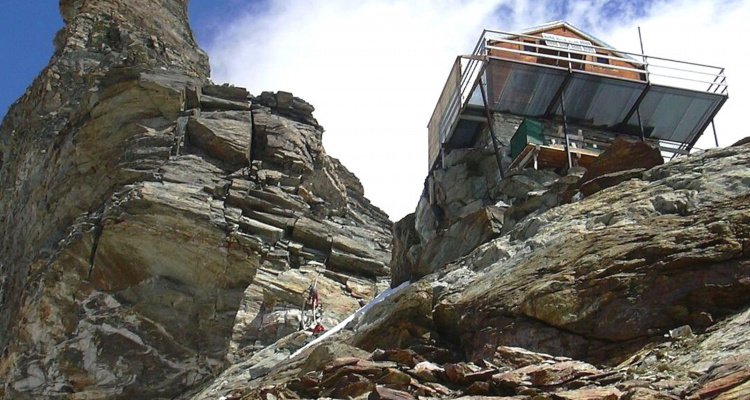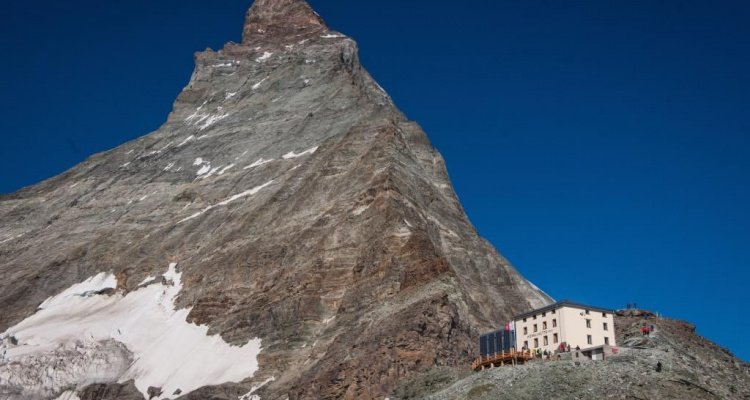Matterhorn Rock Climbing

Mountains have always been drawn in the shape of a triangle with the top pointing towards the sky ... the Matterhorn is considered the perfect mountain and it is just like that: it stands isolated from the rest of the mountain range in the enchanting Valtournenche, it represents the dream of many climbers who would like to reach it at least once in their life...
The Matterhorn Rock climbing
The Matterhorn Rock climbing is possible from two sides: the Italian one called "Cresta del Leone" and the Swiss one called “Cresta dell’Hornli".
Until 1865 the Matterhorn was considered impregnable, legends were telling about the presence of evil spirits and mountain demons until the British climber Whymper managed to conquer it through the Swiss route. Whymper had tried in vain to persuade his friend Carrel several times to attempt the ascent of the Matterhorn from the Swiss side.
When he was informed that Carrel had already started towards the summit of the Matterhorn via the normal Italian route, he decided to leave Zermatt to attempt the climb through the Swiss route. Whymper arrived first, but during the descent the first four climbers of the roped party plummeted. Both routes for the ascent to the Matterhorn were opened and from that day thousands of climbers dream of reaching the summit of the Matterhorn.
 Libro Vetta del Monte Cervino, Pinterest
Libro Vetta del Monte Cervino, Pinterest
Cresta del Leone: the normal italian route
The normal Italian route is more difficult to climb than the Swiss one, despite the difference in height. You move on more technical terrain where you need to be prepared to act with ease and overcome difficulties quickly.
The Matterhorn rock climbing via the Italian route can be divided into 3 stages:
- - from Breuil-Cervinia (2012 m) to the Duca degli Abruzzi Refuge (2,802 m)
- - from the Duca degli Abruzzi Refuge to the Jean-Antoine Carrel Refuge (3,830 m)
- - from the Jean-Antoine Carrel refuge to the summit (4.478 m)
The first stage of the Matterhorn rock climb is based on hiking, no technical difficulties. It is a walk of about 2 hours that from Cervinia leads up to 2,802 m passing through the small church of the “Alpini Battaglione Aosta" where there is a large cross in memory of Pope John Paul II. Continuing you can also admire a suggestive waterfall. You can save 500 meters of climbing by using the ski lifts that arrive from Cervinia to Plain Maison and then continue on foot for about 90 minutes.
The second stage of the normal Italian route is mixed: the first part is a pleasant hike and after a walk through gentle slopes you arrive at the Croix Carrel which will lead up to Colle del Leone, separating the Lion's Head from the Matterhorn. From here the start of the real climbing that will lead up to the Jean-Antoine Carrel Refuge, managed by the guides of the Matterhorn. Here do the climbers generally spend the night, preparing for the demanding climb to the top of the Matterhorn.
The third stage is the real ascent of the Matterhorn facilitated by fixed ropes and fixed metal ropes, the most famous is the Jordan Staircase which allows you to climb a very exposed overhanging slab of about ten meters.
The Italian peak m. 4,476 is marked by a cross and on one arm you can read the word Pratumbor (Latin name for Zermatt) while on the other Vallistornench (Latin name for Valtournenche).
 Rifugio Carrel, Pinterest
Rifugio Carrel, Pinterest
Hornli Crest: the normal swiss route
The Hornli crest is the normal Swiss route and is simpler than the normal Italian route, despite the difference in height to be climbed is around 1,200 meters. The climb is technically challenging, terrain is essentially rocky while the ice is only in the final part.
The ascent to the Matterhorn via the normal Swiss route can be divided into 2 stages:
- - from Zermatt (1,616 m) to Hörnlihütte (3,260 m)
- - from the Hörnlihütte to the summit of the Matterhorn (4,478 m)
The first stage of the Matterhorn Rock climbing is hiking: starting from Zermatt you reach the Schwarzsee (Black Lake 2,584 m) via a path or using the Matterhorn Express cable car. Walking the trail takes from 2 to 3 hours. From Schwarzsee is the ridge reached via a path, first with hairpin bends and later with walkways and ladders on the rocky wall.
The second stage consists in mountaineering, very long and tiring, it requires about 9/10 hours of climbing using fixed ropes and climbing slopes and rocky walls. Just below the summit you will see the statue of San Bernardo, protector of mountaineers. The Swiss peak is 2 meters higher than the Italian peak.
 Hörnlihütte, Pinterest
Hörnlihütte, Pinterest
Matterhorn rock climbing: rules to follow
In the mountains, prudence is the main rule, this also means always evaluating one's abilities very well.
Fitness is a fundamental requirement to be able to safely tackle a climb: an adequate medical check-up must be carried out to practice a sport with challenging difficulties.
Fatigue is one of the main causes of accidents, for this reason it will be necessary to very carefully evaluate your possibilities and physical condition.
The ideal is to always train in the mountains facing increasing difficulties and reaching gradually higher and higher altitudes: climbing requires a great deal of muscle effort, coordination and strength that can only be developed by training in a mountain environment with all the variables that this presents.
Acclimatization is also very important: the reduction in oxygen becomes evident above 3,000 m and the body must get used to compensating this change. Lack of acclimatization can cause “altitude sickness” with nausea, loss of appetite, headache and excessive fatigue (better to go down in this case).
It is important to keep in mind that training at low altitude does not prevent altitude sickness and that a too rapid climb exposes the athlete to this, the ideal would be to provide an overnight stay at an intermediate altitude.
At the basis of good mountaineering preparation there is also good hiking preparation that helps to reduce recovery times and general fatigue.
 Pinterest
Pinterest
Book your next vacation to discover the Matterhorn